Rheology of pre-crystallised chocolate masses
- Like
- Digg
- Del
- Tumblr
- VKontakte
- Buffer
- Love This
- Odnoklassniki
- Meneame
- Blogger
- Amazon
- Yahoo Mail
- Gmail
- AOL
- Newsvine
- HackerNews
- Evernote
- MySpace
- Mail.ru
- Viadeo
- Line
- Comments
- Yummly
- SMS
- Viber
- Telegram
- Subscribe
- Skype
- Facebook Messenger
- Kakao
- LiveJournal
- Yammer
- Edgar
- Fintel
- Mix
- Instapaper
- Copy Link
Posted: 4 November 2013 | Wolfgang Danzl, Head of Laboratory of Chocolate Technology, Fraunhofer IVV and Dr Gottfried Ziegleder, University of Applied Science | 2 comments
Chocolate can be described as a suspension consisting of non-fat particles (sugar, cocoa solids and milk powder particles) dispersed in cocoa butter and a portion of milk fat as a continuous phase. Its unique pleasant taste is produced by a complex interaction of odour-active volatile compounds, which are supplementary to the fine bitterness of cocoa and the sweetness of sugar. The characteristically pleasant mouth-feel is produced by the melting behaviour of cocoa butter, its flavour release and the rheological properties of the melting mass.
During the final stage of production, the chocolate mass is produced as a molten dispersion. Rheology of molten chocolate masses has been extensively studied and reported in the literature1,2. Before forming chocolate products, fat crystals must first be developed as a seed material during chocolate tempering. Then, the structural characteristics of chocolate masses are not only influenced by suspended non-fat particles but also by a tiny portion of crystallised cocoa butter. The properties of such pre-crystallised (= tempered) chocolate masses are strongly dependent on temperature and shear forces. While molten chocolates are measured at 40°C pre-crystallised, masses require a measurement at the typical processing temperatures of approximately 30°C – 32°C. The measurement should be smooth as well as rapid to avoid changing the metastable pre-crystallised state.
Shear viscosity of molten chocolate tends to be measured using rotational rheometers fitted with concentric cylinder geometry1. A procedure for this has been recommended by the International Office of Cocoa3. For pre-crystallised masses, a plate cone geometry seems to be preferable in order to avoid any time delays during sampling. The IOC previously recommended use of the Casson model to evaluate the flow curves and to obtain the Casson yield stress and plastic viscosity. However, use of the Casson model has proven to lead to poor reproducibility of data and has therefore been replaced1. Today, several other rheological models for characterisation of molten chocolate are in use4.
Method
We recorded flow properties of pre-crystallised chocolate mass on a shear stress controlled rheometer (AR 1000, TA Instruments), applying a plate cone geometry with cone diameter 40 millimetres, angular 2° and 100 µm truncation. The instrument was equipped with a Peltier tempering unit, a tempering hood and a water cooling system. The temperature was set to the temperature of the industrial machine, from where the pre-crystallised chocolate sample was drawn. A sample of approximately one millilitre was placed on the plate and the cone was lowered to the truncation gap. Excess chocolate discharged from the gap was wiped off with a spatula. After a pre-shear rate of 5 s-1, measurements were carried out by logarithmically increasing shear stress from 0.01 to 100 s-1, then a short shearing at 100 s-1 for one minute followed by a logarithmically decreasing stress ramp from 100 to 0.01 s-1. The flow curve of the return run was evaluated using the Herschel-Bulkley equation.
The main advantage of the plate cone geometry in comparison to a concentric cylinder is that the sample may be rapidly brought into the shear gap without relevant temperature changes or inclusions of air. The geometry may easily be cleaned within a series of measurements. In single cases, measurements may have to be stopped if remaining agglomerates, larger than 100 µm, block the free flow within the gap. But in most cases this geometry can be used due to the fineness of chocolate masses, which has about 99 per cent of particles smaller than 60 µm and 90 per cent smaller than 20 µm5.
Results
Two types of dark chocolate with fat contents of 32 per cent (D32) and 37 per cent (D37) were tested. The higher fat content enabled a better flow in chocolate D37. The flow curves of D32 tempered in an industrial tempering machine between 29.3 and 30.0°C are shown in Figure 1. With decreasing temperatures, the so-called tempering degree increases. Then, an increasing portion of cocoa butter crystals is formed and higher shear forces are required for the chocolate flow. As a consequence of this seed material, the rheological properties of pre-crystallised masses are more temperature dependent than those of molten masses. Especially yield values are sensitive to temperature variations. At high yield values, sliding effects are caused in the geometry at a shear rate of about 0.1 s-1 and a characteristic step is then found in the flow curve. So, yield values have to be extrapolated as shown in Figure 1. Using the Herschel-Bulkley model, yield values of about 30 Pa (30°C), 70 Pa (29.5°C) and 93.3 Pa (29.3°C) were found for pre-crystallised D32.
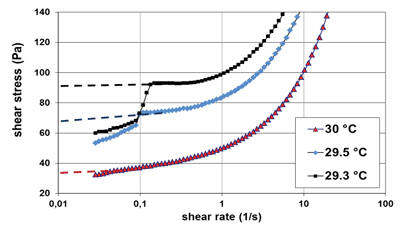

Figure 1: Flow curves of pre-crystallised dark chocolate masses. Fat content 32 per cent. Tempered at 29.3°C, 29.5°C and 30.0°C in a Sollich Minitemper Turbo TFD 100 tempering machine. Extrapolation of the yield values
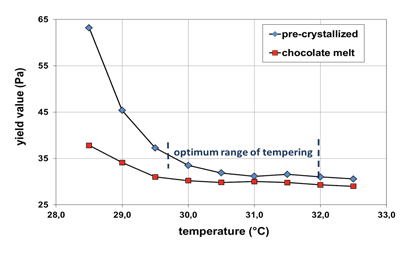

Figure 2: Yield values of dark chocolate masses, pre-crystallised and measured at different temperatures; an optimum range of tempering is indicated. Yield values of the melted chocolate mass, under-cooled and measured at different temperatures. Fat content 37per cent
Figure 2 compares yield values of differently pre-crystallised chocolate masses D37 and the molten mass. The increasing difference in the yield stress at temperatures below 30°C produces evidence that the thickening of the pre-crystallised mass is mainly caused by the additionally crystallised fat and less by the lower temperatures. For industrial use, there is an optimum range of tempering, which is specific for every mass and between 28.7°C and 32.0°C in the case of D37. At optimum tempering, the mass flow is only slightly altered by seed material, and the mass has good properties for its further use. The pre-crystallised chocolate D37 would be defined as over-tempered at about 28.5°C. If used for production, a dull surface and a rough texture encircling many air bubbles would be generated. As we know from thermo-analytical measurements, the proportion of crystallised fat is about 0.01 to 0.1 per cent within this optimum range. Viscosities show only a smaller difference between the molten and tempered state (Figure 3), but as expected, viscosity increases with decreasing temperature. The yield value arises mainly from the inter-particle reactions, which means that it is highly affected by additional seed crystals, while viscosity is more dependent on the distance between the solid particles and therefore mainly influenced by the fat content6. The temperature of the optimally-tempered mass is low enough to not melt the cocoa butter seed crystals. At temperatures above 32°C, the mass would be called under-tempered, which relates to too low a concentration of seed crystals near to the melting point.
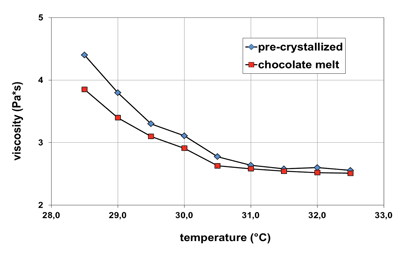

Figure 3: Viscosities of dark chocolate masses. Fat content 37 per cent. For explanations, see Figure 2
The tempering degree of a chocolate mass is usually defined using a temper meter. These instruments all rely on the measurement of a cooling curve of the pre-crystallised chocolate mass, as the cocoa butter in this mass crystallises in a specific way. Then, the cooling curve is influenced by the generated crystallisation heat. The resulting diagrams help to differ between under-tempered, tempered and over-tempered chocolate6, and a temper index may be calculated. A temper index of four to six seems ideal for most chocolate applications. Figure 4 shows the correlation of yield values and temper indices in the case of the pre-crystallised chocolate mass D32. During optimum tempering, the yield values remain nearly constant, but a temper index higher than 6.5 will indicate an over-tempered status, which is combined with a significant increase of the yield value. Therefore, the yield value could be used to control tempering for a chocolate mass of known recipe.
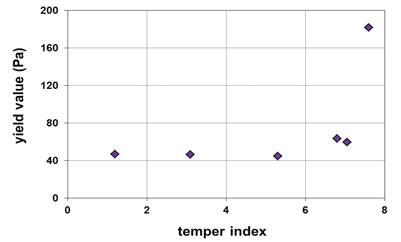

Figure 4: Correlation of yield values and temper indices of differently pre-crystallised dark chocolate masses. Fat content 37 per cent. Temper indices measured with a Sollich temper meter
Chocolate products are formed using pre-crystallised mass. There are different forming techniques such as moulding, traditional shell technology, enrobing, cold-matrix or one-shot technology. During most of these processes, chocolate masses flow slowly at low shear rates. Then the rheological properties are mainly dependent on the yield values rather than on plastic viscosities. Vibration is another step that is frequently used in combination with the moulding or enrobing processes7. It is adjusted in frequency to shake the mould and thus improve the mass flow by reducing its yield value. The vibration will release air bubbles from the chocolate and will improve the levelling of the mass just being deposited inside the cavity7.
Concluding remarks
The measurement of the rheology of pre-crystallised chocolate masses must be smooth and rapid in order to not influence the included seed material and destroy the crystalline state. In this purpose, a plate-cone geometry seems very useful. It was shown that the flow curves and mainly the yield values of such tempered chocolate masses are influenced by the tempering state. The yield values play a predominant role during the further processing of chocolate masses within the different forming techniques.
The IGF-Project (16763 N/1) of the research association IVLV was supported in framework of the program for promotion of industrial community research (IGF) of the Federal Ministry of Economics and Technology based on a resolution of the German Parliament.
References:
- Wolf B (2011). Rheological properties of chocolate. New Food 14(2): 15-20
- Goncalves E V, Lannes S C (2010). Chocolate rheology – review. Cienc. Tecnol. Aliment., Campinas, 30(4): 845-85122
- International Office of Cocoa (IOC) (2000) Viscosity of Cocoa and Chocolate Products. Analytical Method 46. Available from CAOBISCO, rue Defacqz 1, B-1000 Bruxelles, Belgium
- Afoakwa E O, Paterson A, Fowler M, Vieira J (2009). Comparison of rheological models for determining dark chocolate viscosity. Int. Journal of Food Science and Technology 44(1): 162-167
- Ziegleder G, Amanitis A, Hornik H (2004). Thickening of molten white chocolates during storage. Lebensmittel Wissenschaft u. Technology 37: 771-778
- Talbot G: Chocolate temper. Chapt. 12 in: Industrial chocolate manufacture and use. Edit. S.T. Beckett. 4th ed., Wiley Blackwell, 2009
- Roncato M (2011) Chocolate moulding – process and equipment. The Manufacturing Confectioner 91 (9), 79-86
About the authors
Wolfgang Danzl is a brewing engineer (Technical University of Munich). For the last three years, he has led the laboratory of chocolate technology at Fraunhofer IVV, Freising and organised the Chocolate Group of the Industrial Organisation IVLV, Munich.
Dr Gottfried Ziegleder holds doctorate degrees in chemistry (University of Munich) and food technology (Technical University of Munich). He was head of the Department of Food Technology at Fraunhofer IVV, Freising for over 20 years, before retiring in 2010. He continually works with the chocolate industry and teaches Chocolate Technology at University of Applied Science, Weihenstephan.



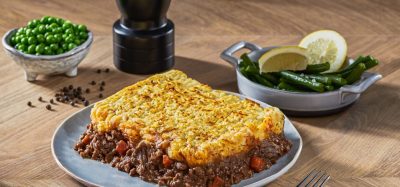





I would like to read the whole article.
Thank you,
Ellen
Hi Ellen, you can read the whole article by registering here. It’s free and will enable you to read this and all the other premium content across the website.